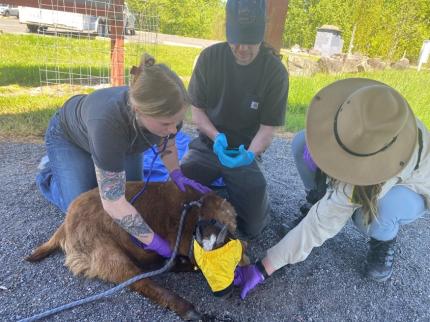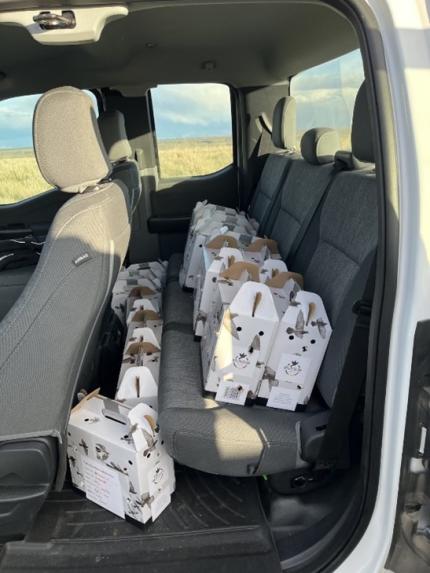
Wildlife Program report: Apr. 16-30, 2024
Managing Wildlife Populations
Skagit Wildlife Area Management Plan: The SEPA 30-day public review on the draft Skagit Wildlife Area Management Plan ended on April 22. The department received 14 sets of comments including letters from Skagit Audubon, Washington Trails Association, and Washington State Senate Republican Caucus. Lands Division and regional staff members are working on the comment responses at this time. Lands Division expects the final plan internal review by the end of May, with the final document being delivered to the Director in June for his signature.
Managing Wildlife Populations
Prairie Grouse: Biologist Lowe was in British Columbia trapping sharp-tailed grouse that were subsequently transported and released in either Lincoln or Douglas county as part of a translocation effort to augment existing local populations.
Biologist Brinkman assisted Swanson Lakes Wildlife Area Manager Finch setting up release boxes for sharp-tailed grouse on an existing lek in Lincoln County. Translocated birds get placed into the release boxes for 15 to 20 minutes to settle before being released into their new home.

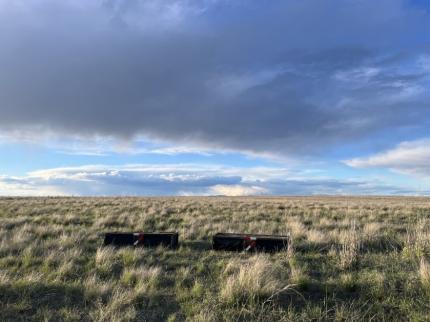
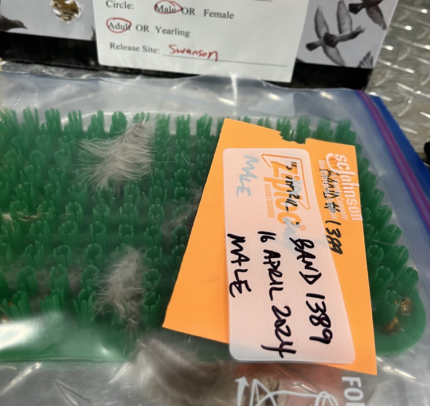
Prairie Grouse: Biologist Lowe was in 70 Mile House, British Columbia trapping the remaining four sharp-tailed grouse needed to complete the translocation effort for this year. The remaining four grouse were released in Lincoln County on the Swanson Lakes Wildlife Area at an existing lek. In total, 60 birds (30 males and 30 females) were captured, transported, and released over six days during this year’s translocation. On the final day of capture, Photojournalist Joel Sartore from National Geographic met the trapping crew to photograph the birds for his Photo Ark project.
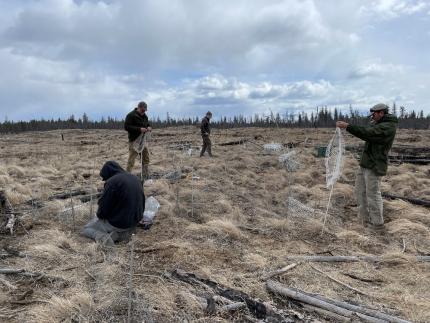
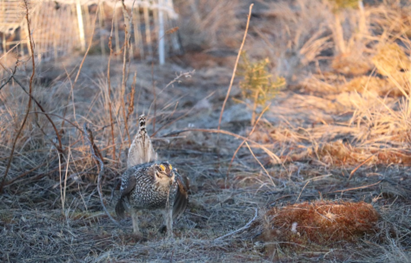
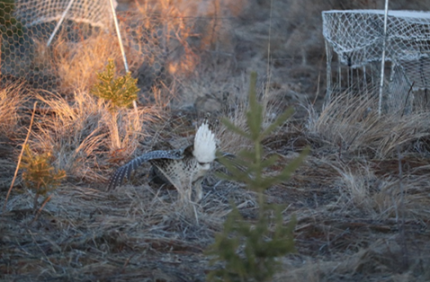
Conserving Natural Landscapes
Prescribed Burn Preparation: Fire Planner Lionberger and Sherman Creek Wildlife Area Assistant Manager Palmer performed fire control line preparation at Rustlers Gulch Wildlife Area. The pair dragged small pasture harrows pulled by an All-Terrain Vehicle (ATV) and a Utility Terrain Vehicle (UTV) to prepare lines for any needed bulldozer use during burning. These lines are essentially fire boundaries.
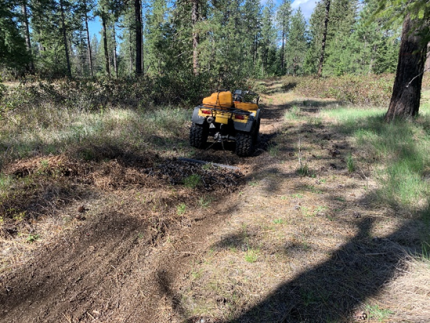
Columbia Plateau Wildlife Management Association (CPWMA) Work Party: Private Lands Biologist Nizer worked with CPWMA on a hunt by written permission property. They seeded between two and three acres of an unproductive field into alfalfa strips, clover, and barley. Nizer helped seed with the ATV and with clearing out debris and fencing on the property.
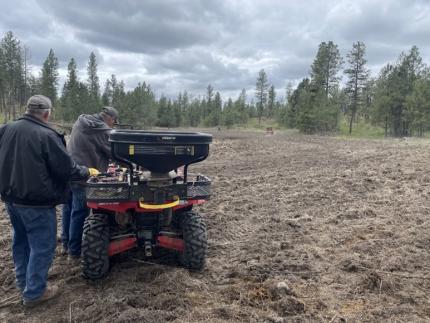
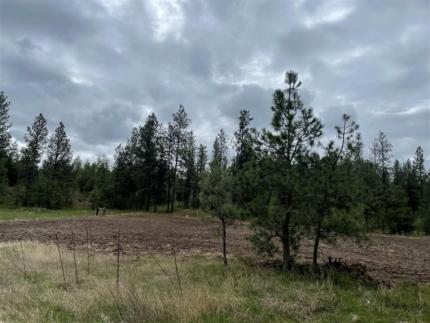
Providing Education and Outreach
Dayton Kid’s Fishing Event: Wildlife Area Manager Dingman and Natural Resource Technician Tritt helped with two kids' fishing events in Dayton. Both events were held on the same day, the first event included the kids from The Boys & Girls Club in Dayton and the second event was sponsored by the city of Dayton. There were approximately 100 kids total who attended and fished the Kid’s Pond in Dayton.
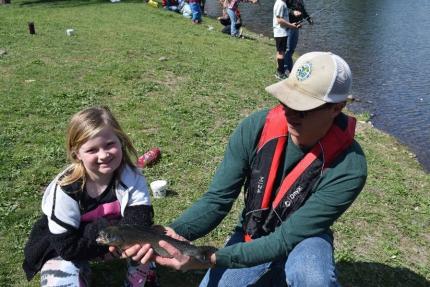
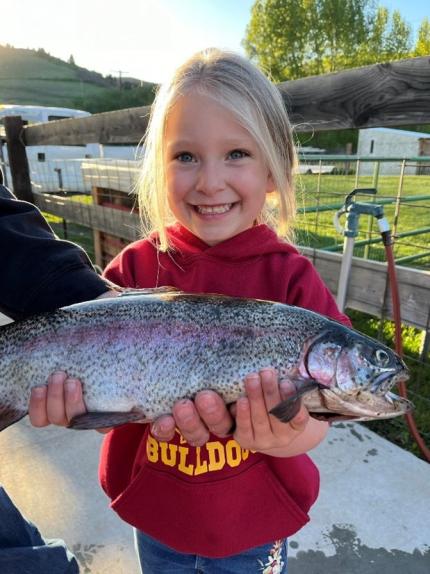
Conducting Business Operations and Policy
South Fork Hayshed Repairs: Wildlife area staff members improved the South Fork hayshed by installing metal siding over the gable ends. The metal covers exposed wood and closes holes that were allowing birds to enter the building. A rental snorkel lift made the job much easier and safer. New bat boxes were also installed on each end of the building.
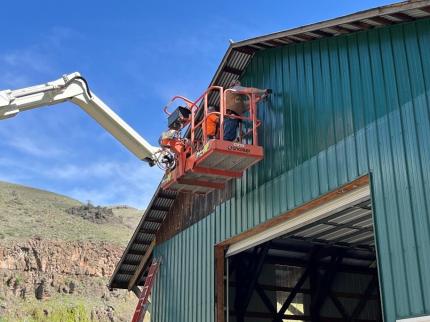
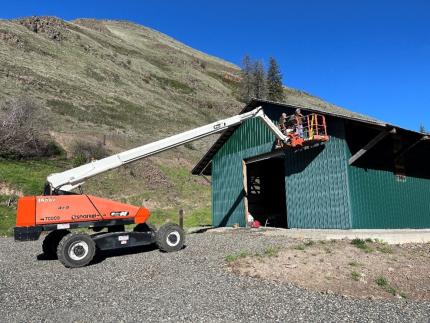
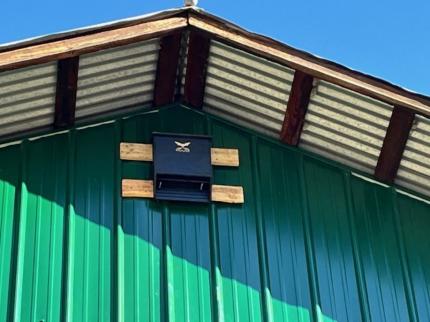
Managing Wildlife Populations
Greater Sage-grouse: Biologists across Douglas County are finishing up monitoring known greater sage-grouse lek sites. Sage-grouse numbers recorded so far this spring represent an increase over the previous several years. This is very encouraging to see because this species is classified as Endangered in Washington and has been experiencing a dramatic population decline for many years now. For more information on greater sage-grouse in Washington, visit the Washington Department of Fish and Wildlife website.
Columbian Sharp-tailed Grouse Translocation: Biologists Eilers joined other biologists to trap and relocate 60 sharp-tailed grouse from British Columbia, Canada into Washington. This will help supplement the species abundance and genetic diversity in Washington. Sharp-tailed grouse are State Endangered and are a Species of Greatest Conservation Need due to their low and declining numbers in Washington.
The translocation effort involved finding leks (breeding display grounds where males dance to attract females) in British Columbia, setting up walk-in traps, and then returning each morning to watch from a blind as the birds performed their daily displays. Once a bird found itself in a trap, biologists quickly left the blind and captured the bird to bring it to a processing site. All 60 grouse (30 males and 30 females) were banded, and half of them were outfitted with a radio collar to allow biologists to track their movements. Half of the birds were released in northern Douglas County and the other half were released in Lincoln County. For more information about this species visit the Washington Department of Fish and Wildlife website.
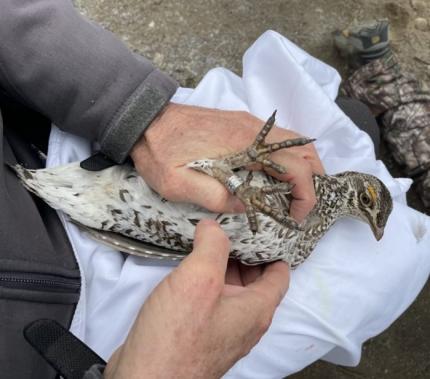
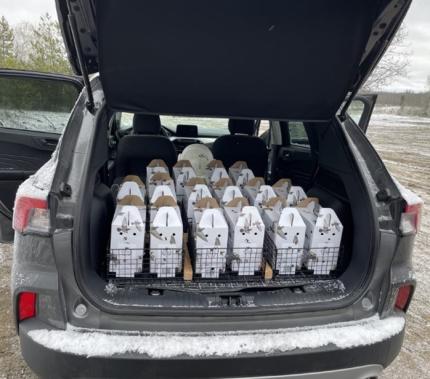

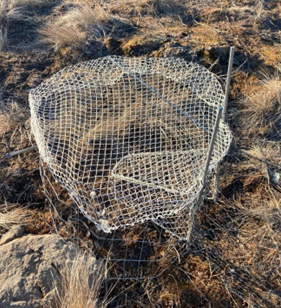
Sharp-tailed Grouse Management: Biologist Heinlen traveled to 70 Mile House, British Columbia and participated in trapping Columbia sharp-tailed grouse for augmentation back into Washington. After much planning, logistical coordination, and field work by many staff members, everything aligned perfectly, and 60 (30 males and 30 females) sharp-tailed grouse were captured and successfully released in Washington in six trapping days. The goal is to bolster the Washington population by increasing genetic diversity.
Biologist Heinlen also conducted annual surveys for Columbia sharp-tailed grouse within District 6. Relocating leks (breeding grounds) that have moved, and a mild winter has led to a better survey effort and an increase in sharp-tailed grouse numbers over the 2023 surveys.
Biologist Heinlen and Confederated Tribes of the Colville Reservation Wildlife Biologist Laspa toured a property in Tunk Valley that the tribe acquired a couple years ago. Before the tribe acquired the property, Biologist Heinlen conducted the sharp-tailed grouse surveys on it. During the tour Biologists Heinlen and Laspa were fortunate enough to relocate a lek that hasn’t been active in over 20 years.

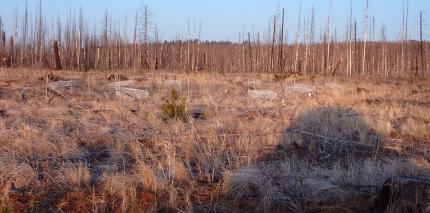
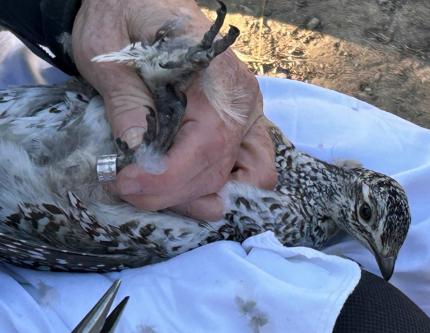
Sage Grouse Surveys: Biologist Morris completed grid searches for sage grouse in Grant and Douglas counties. Morris saw some great sunrises, picturesque landscapes, and lots of upland birds while surveying.
Bighorn Sheep Management: Biologist Heinlen investigated a bighorn sheep mortality in the Mt. Hull herd. Not enough was left to determine a definitive cause of death. However, disease and parasite samples were taken and sent to Washington Animal Disease Diagnostic Laboratory at Washington State University for analysis. The radio collar was also retrieved.
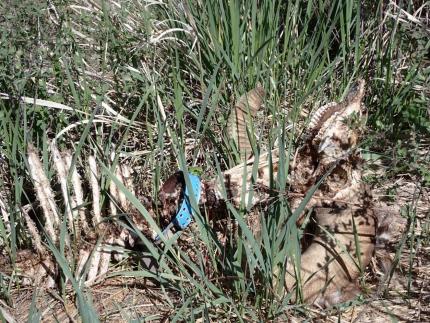
Mule Deer Management: Biologist Heinlen and Washington Department of Fish and Wildlife Volunteer Fischer investigated a mule deer mortality. They found it to be predated by a cougar. The radio collar was recovered.
Convention on International Trade in Endangered Species (CITES) Sealing: Biologist Heinlen sealed several bobcat pelts from Okanogan County with CITES tags this period. CITES is an international agreement that aims to ensure that international trade in specimens of wild animals and plants does not threaten their survival. Because the trade in wild animals and plants crosses borders between countries, the effort to regulate it requires international cooperation to safeguard certain species from over-exploitation. The deadline for sealing has now passed. All bobcat and river otter pelts harvested this season were required to be sealed by April 20.
Lek Searches: Biologist Turnock and Technician Hara continued searching for new sage and sharp-tailed grouse leks in northern Douglas County. High winds have made surveying difficult, but they were able to cover four grids. This will help inform our understanding of these species’ distributions in Region 2.
Sharp-tailed Grouse Translocations: Technician Force assisted staff members in translocating 60 sharp-tailed grouse from British Columbia to Dyer Hill and Swanson Lakes Wildlife Areas.
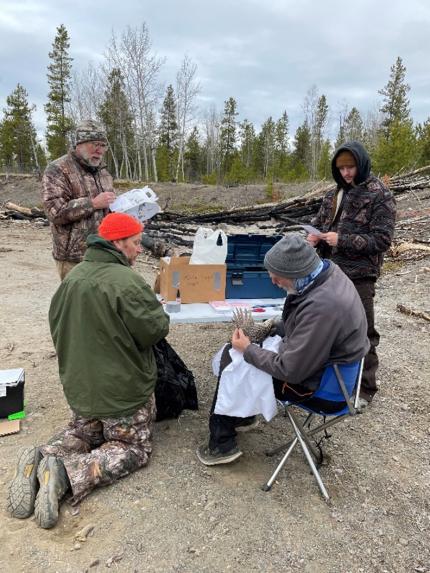
Northern Leopard Frog Surveys: Biologist Turnock and Technician Hara conducted northern leopard frog breeding surveys in District 5, including at Potholes off road vehicle (ORV) park. They did not detect any leopard frogs, but these surveys resulted in some exciting incidental observations such as a badger with three young and breeding Great Basin spadefoot toads.
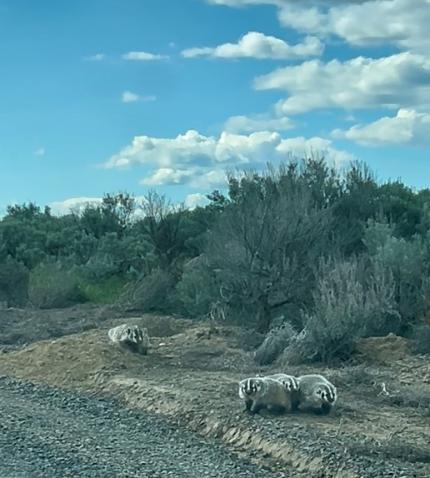
Pygmy Rabbit Trapping: Biologist Turnock and Technician Hara assisted Biologist Crowell with pygmy rabbit trapping at the B3 enclosure near Beezley Hills. They were able to capture the enclosure’s lone resident, an adult male rabbit, to confirm his survival.

Providing Recreation Opportunities
Hunter Access: Biologist Morris checked and posted signs on hunter access properties.
Providing Conflict Prevention and Education
Deer Issues: Specialist Heilhecker spoke with a landowner regarding acclimated deer in his yard. A group of seventeen deer have been eating flower gardens and walking across the porch. Specialist Heilhecker provided recommendations on how to nonlethally haze the deer.
Cost-Share Fencing: Specialist Heilhecker ordered fencing materials for an orchard experiencing deer damage. The orchardist signed a cost-share fencing agreement. Subsequently, Washington Department of Fish and Wildlife orders materials and arranges for the materials to be delivered onsite. Then, the orchardist installs the fence.
Range Rider Information Sharing: Specialist Heilhecker answered questions from an individual interested in becoming a contracted range rider. She met with wildlife conflict section staff members to discuss the individual’s application and funding availability.
Conserving Natural Landscapes
Habitat Plots: Biologists Cook and Morris pulled cheatgrass weeds from around 200 recently planted shrubs, from this spring and last year. Plastic mulch was used but the weeds were aggressively growing through the holes cut for the planted shrubs. Machine cutting the grass was unfeasible due to the small size of some shrubs and the thickness of weeds. Pre-emergent herbicide will be used to prevent regrowth of weeds.
Habitat Plots: Biologist Morris sprayed weeds at one of the habitat plots he has been working on. By controlling weeds, it allows the native plants to get established with less competition for available soil moisture and nutrients. Around 200 of the native trees and shrubs were planted in plastic mulch to prevent weed competition, but cheatgrass was growing through the holes where the shrubs were planted. Biologist Morris and Biologist Cook spent some time removing the cheatgrass manually from these holes.
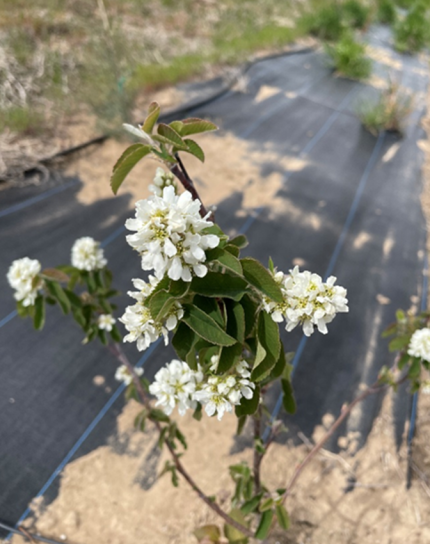
Providing Education and Outreach
Science, Technology, Engineering and Math (STEM) Day in the Field: Biologist Cook participated in the Science, Technology, Engineering and Math (STEM) day in the field at the Desert Unit of Columbia Basin Wildlife Area. Cook participated in providing instruction for groups of 6th graders around wildlife resources and their effect and interaction with the environment.
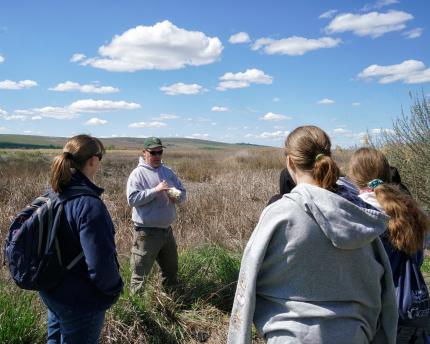
Turkey Hunting Information: Specialist Heilhecker provided feedback to a hunter who called looking for places to hunt turkeys.
Conducting Business Operations and Policy
Wolf Advisory Group Meeting: Specialist Heilhecker participated in the Wolf Advisory Group (WAG) meeting and participated in the WAG coordination meetings.
Firearm Certification: Specialists Heilhecker and Bridges, and Supervisor Rickel all completed annual firearms qualifications.
Other
CPR Training: Specialist Heilhecker, Supervisor Rickel and Private Lands Biologists Braaten, Morris and Cook attended CPR training in Ephrata.
Managing Wildlife Populations
Oak Creek Wildlife Area Wildlife Safety Zone: Oak Creek Wildlife Area Natural Resource Worker O’Brien built and installed a new wildlife safety zone signpost. This sign informs hunters of the wildlife safety zone located directly around the Oak Creek Wildlife Area headquarters office and feed yard.

White Nose Syndrome Probiotic Bat Captures: District 4 Wildlife Biologists Fidorra and Hoffman, District 8 Wildlife Biologist Moore, and Sunnyside-Snake River Wildlife Area Manager Kaelber assisted Washington Department of Fish and Wildlife Bat Biologist Tobin with the capture and sampling of a maternity colony in the Sunnyside area. The team successfully captured approximately 60 new bats and recaptured 20 bats that were marked and sampled during previous efforts. This research effort is a novel approach to utilizing naturally occurring bacteria to reduce impact of the causative agent of white nose syndrome (WNS). One more capture event is planned for later this summer. Additionally, guano samples were collected and will be tested for Pseudogymnoascus destructans (Pd), the fungus that is known to cause white-nose syndrome in bats.
Providing Recreation Opportunities
L.T. Murray Wildlife Area Opener: It was chilly and windy but a beautiful day on the L.T. Murray Wildlife Area for the May 1 elk closure opener. Around 120 vehicles lined up for the 6 a.m. rush through the gates at Joe Watt and Robinson Canyon, which yielded few antlers, but it was still a great time for people on horseback, all-terrain vehicles, bicycles, cars, and trucks.
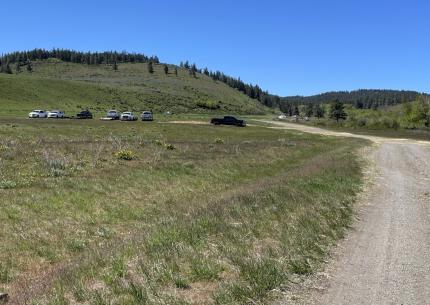
Providing Conflict Prevention and Education
Central Washington University (CWU) Students in Taneum Creek: L.T. Murray Wildlife Area Manager Morrison led geology students and members of AWRA (American Water Resources Association) on a field tour in the L.T. Murray’s Taneum Creek system. The field day objective was to learn about riparian projects implemented by Washington Department of Fish and Wildlife and Yakama Nation Fisheries.
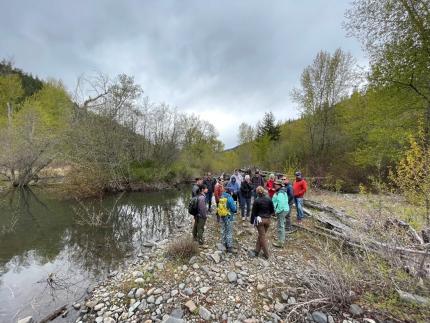
Whiskey Dick Creek Bird Count: Central Washington University Cultural and Environmental Resource Management graduate student started bird point count data in the Whiskey Dick Creek system for a thesis focused on shrubsteppe songbird response to fire-based vegetation response.
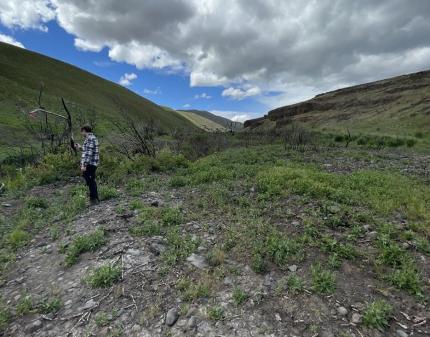
District 4 Rattlesnake Hills Elk: District 4 Wildlife Conflict Specialist Hand had continued to conduct hazing activities near the border of the Hanford National Monument. Increasing numbers of animals are being observed entering wheatfields along the southern border of the monument.
District 4 Corral Canyon Elk Area Summer Bull Permits: District 4 Wildlife Conflict Specialist Hand prepared damage prevention permits (DPP) to be delivered to landowners in elk area 3721. These permits assist with pressuring elk away from valuable wheat crops during critical plant development. These permits were the first to be developed and issued from the new Damage Permit System platform.
District 4 Master Hunter and Special Permit Points Restoration: District 4 Wildlife Conflict Specialist Hand worked with Headquarters staff members on identifying which master hunters or special permit holders were not deployed on damage hunts, so their special hunting permit points could be restored.
District 4 Deceased Pronghorn: District 4 Wildlife Conflict Specialist Hand received and responded to a report of a car/pronghorn antelope collision on Highway 221. No collar or ear tag was observed on the animal and biological information was collected and entered in Survey 123.
Conserving Natural Landscapes
Wenas Wildlife Area Spring Weed Treatments: Wenas Wildlife Area staff members continue to treat the wildlife area for noxious weeds. This time of year, a common pest is the Scotch thistle. Preventing the encroachment of these noxious weeds is an essential aspect to maintaining the natural landscapes of the wildlife area.
Oak Creek Wildlife Area Noxious Weed Control: Noxious weed control continues on the Cowiche Unit of the Oak Creek Wildlife Area. Oak Creek Wildlife Area Assistant Manager Charlet and Natural Resource Worker O’Brien continue spot spraying efforts to reduce the presence of Scotch thistle and other noxious weeds on Washington State Department of Fish and Wildlife lands.
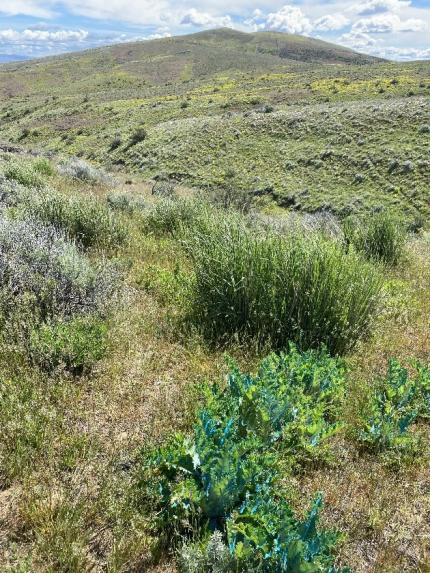
Oak Creek Wildlife Area Parking Area Maintenance: Oak Creek Wildlife Area Natural Resource Worker O’Brien filled potholes and raked gravel in parking lots on the Oak Creek Unit to improve parking areas. Assistant Manager Charlet sprayed parking lots on the Oak Creek Unit and Cowiche Unit for a wide variety of nonnative plant species. This effort reduces the risk of noxious weeds spreading onto Washington Department of Fish and Wildlife lands and reduces wildfire risk by eliminating vegetation where vehicles commonly park.
Wenas Wildlife Area Future Conservation Easements/Acquisitions: Wenas Wildlife Area Manager Gray continued to work with two landowners who are interested in conserving their private property to prevent future development and protect the current habitat. Gray and Region 3 Lands Agent Carbary met with a landowner off Umptanum Road to discuss potential options for conserving their property and to conduct a site visit. The property is approximately 3400 acres of shrubsteppe and riparian habitat. Gray and Wenas Wildlife Area Habitat Specialist Miller will be submitting this project area through the internal Lands 20/20 process for review this year.
The second project area is approximately 440 acres of shrubsteppe, ponderosa pine woodland, and riparian habitat. Gray and Miller have been working on a RCO (Recreation and Conservation Office) WWRP (Washington Wildlife and Recreation Program) – Critical Habitat grant to receive funding for a conservation easement and life estate for this property. This past week Gray met with a professional photographer and the landowners to take photos of the property to be used in the grant application. Both of these projects will protect crucial areas of habitat for wildlife including a significant number of species listed as Species of Greatest Conservation Need (SGCN).
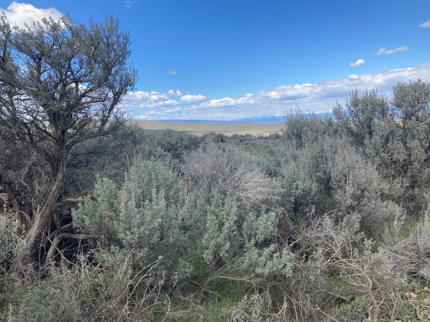
Sunnyside-Snake River Wildlife Area / Region 3 Private Lands collaboration with Benton Conservation District: Sunnyside-Snake River Wildlife Area Manager Kaelber and Private Lands Biologist Manderbach had a meeting and followed up on a field trip with the Benton Conservation District staff members to the Thornton Unit. They discussed future collaborative efforts to harvest sagebrush and native seeds from plants that can be used to create seed balls to spread throughout Benton and Franklin counties on private lands and portions of the Sunnyside-Snake River Wildlife Area. Other habitat enhancement projects were also discussed.
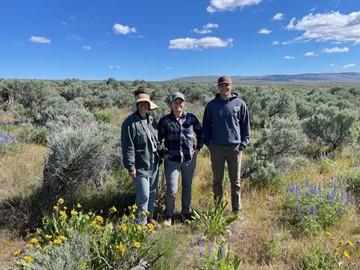
Franklin County Shrub Planting: Private Lands Biologist Manderbach along with help from District 4 Wildlife Biologist Fidorra expanded on a shrub planting from 2023 on the Neff-Jones Hunt by Reservation site in Franklin County. In 2023 sagebrush and antelope bitterbrush were planted in three draws on the property. The sagebrush has survived well, but the bitterbrush had a very low survival rate likely due to deer damage soon after planting. Manderbach and Fidorra planted more sagebrush as well as winterfat and a few patches of Rocky Mountain juniper in two of the draws to expand on the project. Manderbach will continue to monitor the plantings and provide water occasionally throughout the spring and summer.
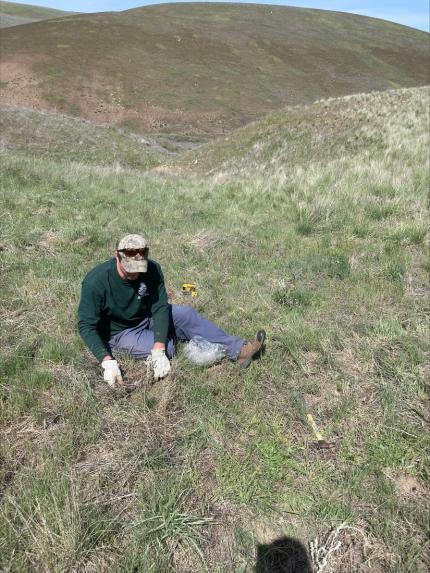
Other
Kittitas County Corner Crossing: Region 3 Private Lands Biologist Manderbach met with a landowner in Kittitas County who called about issues with corner crossing that them and a neighbor are having. Both landowners border state land and there is a fence at the corner being crossed. The landowner gave Manderbach a tour of their land, their neighbors’ land that they work on, as well as some of the state land bordering them.
They discussed many issues and the potential for future collaboration in ways of first-time pheasant hunter opportunities, habitat work potential, and the possibility of allowing public access. The landowner has worked with many Washington Department of Fish and Wildlife staff members on different projects and issues. Manderbach will continue diving into the corner crossing topic.
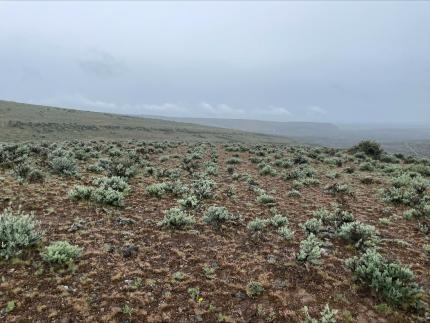
Managing Wildlife Populations
Beaver Rehabilitation – Successful Release and Establishment: A Washington Department of Fish and Wildlife biologist from King County (District 12), worked with PAWS Wildlife Rehabilitation Center to identify potential locations for beaver release. In collaboration with Vashon-Maury Island Land Trust, a site was chosen on Vashon-Maury. The land trust has reported that the beaver released there are hanging around the site and appear to be doing great. It is rare to be able to release beaver in suburban/rural areas of King County, which makes this site unique.
Snow Goose Survey: Wildlife Biologists Waddell and Soltysiak conducted the annual snow goose survey. This survey was conducted in a small single engine airplane and encompassed an area from southern British Columbia southward to northern King County. Flocks of snow geese were photographed for later analysis by AI software.
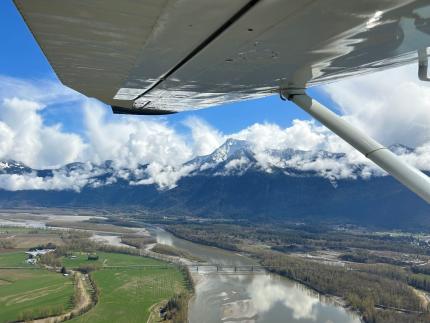
Purple Martin Colony Maintenance: District 12 collaborated with volunteers to maintain the Seattle waterfront purple martin colonies at Duwamish Waterway and Shilshole Bay. Overall, roughly 100 nest gourds were cleaned and maintained for reuse this season (with the bulk of those also used last season). The purple martin is North America’s largest swallow that is a state Species of Greatest Conservation Need under the State Wildlife Action Plan. It is largely dependent on human nest boxes, nest gourds, and other human structures for nesting.
The purple martin is a cavity nesting species that needs snags that are over or adjacent to water to build their nests. Snags are dead or dying trees. Snags are a very specialized and limited habitat type that tends to be very patchy in occurrence. For purple martins, removing a group of snags with cavities that they use can take out an entire local martin colony. Snags are often taken down because they can be a safety hazard, and are also removed to preserve views. Simple management of snags, in the appropriate situation where hazards are not of concern, not only provides habitat, but also great wildlife attraction and watching opportunities.
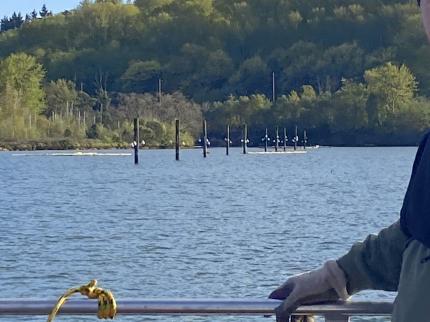
Sooty Grouse Survey: Westside district staff are in ongoing monitoring surveys for sooty grouse, a harvestable forest grouse species, this month and next.


Common Loon Platform Maintenance and Launch: District 12 maintained platforms on two separate territorial common loon lakes. Loons were observed at both lakes. The common loon is a state listed species (Sensitive) and a Species of Greatest Conservation Need in the State Wildlife Action Plan.
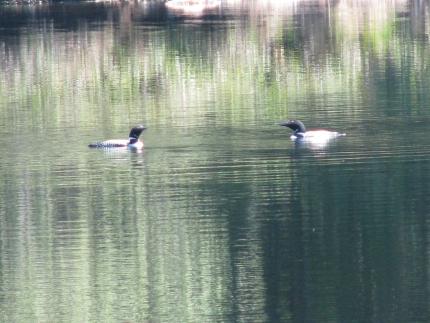
Improving Bat Roosting Habitat in Island and San Juan Counties: Biologist Licence, in collaboration with the Watchable Wildlife Program, Master Hunter Program, Diversity Division, State Parks, Girl Scouts, Bats Northwest, Happy Valley Bats Rehab Center, private citizens/landowners and other partners recently built over 50 multi-chambered bat boxes for distribution to stewards throughout the district.
This group rallied to install nine boxes at Deception Pass State Park. These boxes will provide additional living space for up to 2,250 bats in an area where bat exclusion has occurred over multiple winters in private dwellings nearby. Journalists from the Washington Post and a reporter from the Whidbey News-Times attended the event and conducted interviews.
Many of the additional boxes were donated to homeowners with bats regularly roosting in or near their property and are currently in the process of installing boxes. Fifteen more bat boxes were donated to the San Juan Island Land Bank for mounting and monitoring across San Juan and Orcas islands.
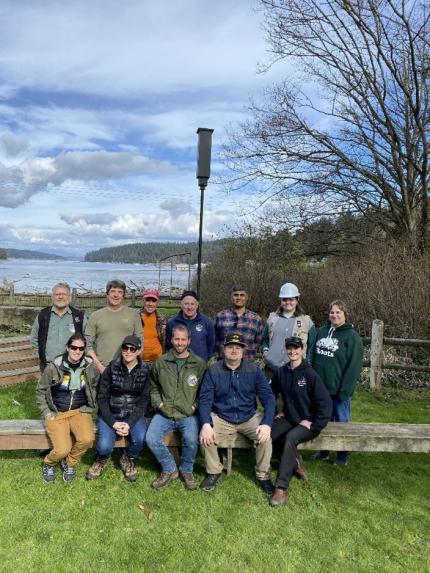
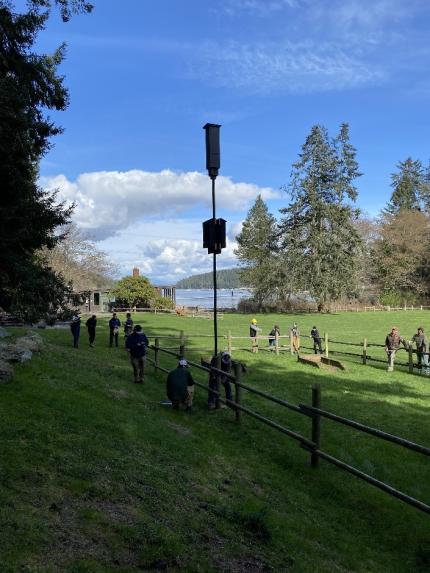
Beach Clean-up Efforts on Whidbey Island: Biologist Licence and master hunters represented Washington Department of Fish and Wildlife to support efforts by the Washington State University Island County Extension Office and Naval Air Station Whidbey to remove litter from beaches with a specific focus on collecting and quantifying plastic shotgun wad debris.
In the past month two separate events took place, one in early April at Windjammer Park in Oak Harbor and the other at Crescent Beach on Earth Day. Combined, volunteers collected hundreds of pounds of litter and well over 1000 shotgun wads.

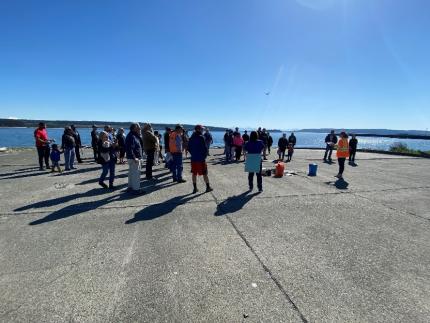
Island Marble Butterfly Spring Monitoring on San Juan Island: Biologist Licence and Pollinator Specialist Combs initiated another year of island marble butterfly (IMB) monitoring on San Juan Island. This week of monitoring included adult relative abundance transects, detection/no detection surveys in known IMB occurrence areas, as well as egg and larvae monitoring at the Cattle Point, Department of Natural Resources property. Staff members also value this time to communicate and build relationships with local conservation partners. The IMB season appears to be earlier this year than in the past and staff members counted 34 recently laid eggs where in recent history no eggs were counted during this early season survey.
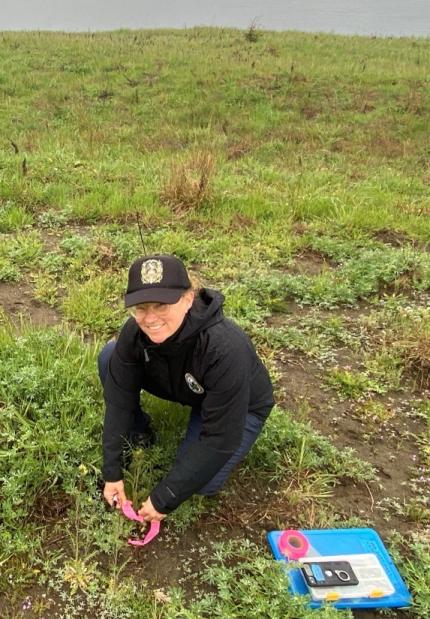
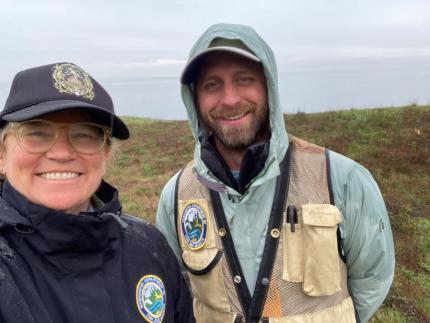
Bat Acoustic Activity Monitoring: Biologist Anderson maintained three solar powered acoustic bat recorders that are running year-round in the district. These are used for various trends in activity – emergence periods, species activity at a site, etc.
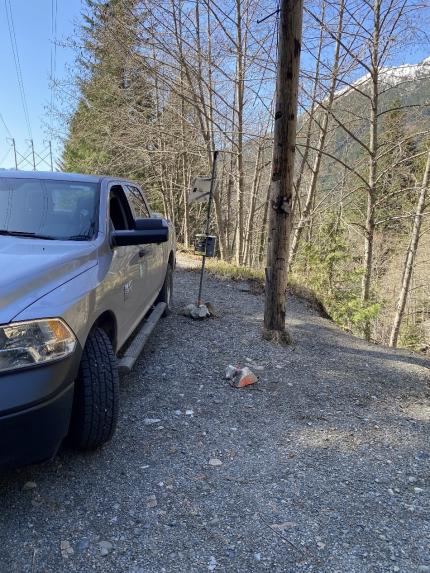
Providing Conflict Prevention and Education
Bobcat and Wallabies – Conflict Prevention: Wildlife Conflict Specialist O’Connor responded to a call regarding a depredation to captive wallabies. Upon arriving at the site, O’Connor noted a bobcat in the wallaby pen, jumping out as he approached. O’Connor went through exclusionary needs and other conflict reduction management techniques.
Providing Education and Outreach
Protected Wildlife – Trail Building Concerns: Biologist Anderson met with Seattle Parks and Recreation, as well as a citizens group, regarding a local natural area that has a mountain bike trail proposed and in the process of development. A state protected active Cooper’s hawk nest was located right above the trail. They determined currently there is no conflict because the trail building will be well away from the active nest.
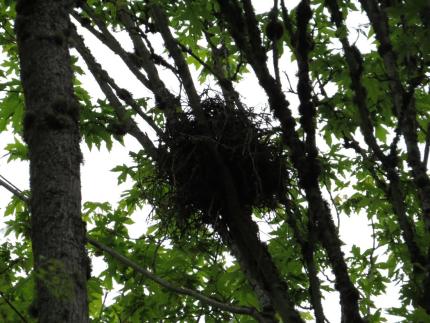
Conducting Business Operations and Policy
Westside Necropsy Training: Wildlife health staff members provided a necropsy training and refresher for staff members for both west and east of the crest. In the west training, one of the specimens acquired was an elk from North Bend that had been spinning and appeared disoriented. Necropsy participants found an injury to the head/base of antler that created an injury, and infection and an abscess on the brain that likely created all the behavioral issues the animal exhibited.
Other

Managing Wildlife Populations
Sooty Grouse Surveys: Washington Department of Fish and Wildlife (WDFW) wildlife biologists in western Washington are in the second year of testing a survey method for sooty grouse (formerly called blue grouse). The effort involves establishing driving routes in the Cascade and Olympic mountains as well as the Willapa Hills.
The routes include 15 to 30 listening stops where biologists spend time listening for the calling of male sooty grouse during the early morning hours. The survey method is borrowed from Oregon Department of Fish and Wildlife as well as Oregon State University and we thank them for their development of the method and sharing. When fully developed and implemented, the survey will generate sooty grouse population trend estimates that are independent of grouse harvest. To date, Biologists Stephens, Holman, Wickhem, and Bergh, along with Conflict Specialist Aubrey and Cowlitz Wildlife Area Assistant Manager Steveson have conducted eight surveys.
An additional component of the work is to use listening devices called Acoustic Recording Units (ARUs) to better understand the timing of the sooty grouse breeding season. This is important since the survey methodology was developed at lower latitudes in Oregon where breeding timing could be different. The ARUs are placed near calling sooty grouse and left in place for approximately two months. During this time, the device records the calling grouse. With several of the units placed throughout western Washington, in aggregate this information can be used to adjust Oregon’s protocol to Washington’s grouse population. Biologist Holman, Conflict Specialist Aubrey, and Enforcement Officer Tippets placed three units in Cowlitz and Lewis counties.
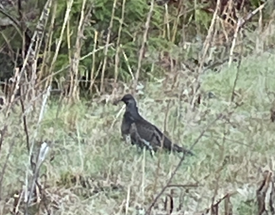
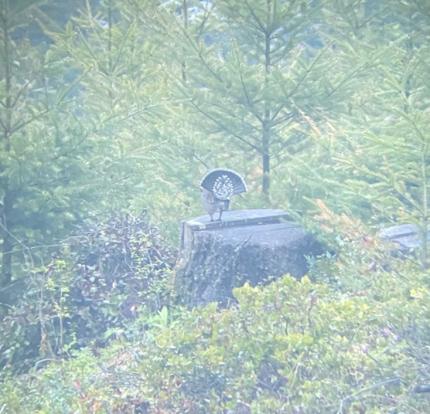
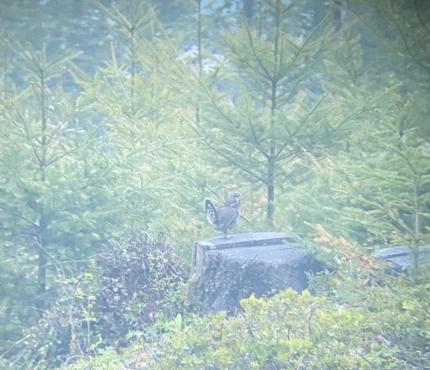
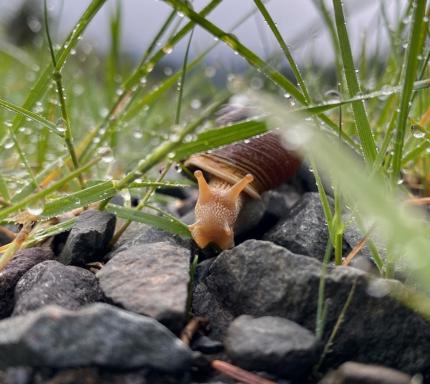
Glenwood Valley Annual Sandhill Crane Survey: Biologists Wickhem, Bergh, and Ott; Data Manager Blatz, Volunteers Castagnoli, Flick, Steider, L. Robinson, D. Robinson, B. Roe, and J. Roe; staff members from Mount Adams Resource Stewards, and staff members from the U.S. Fish and Wildlife Service joined forces for the annual sandhill crane survey on and around Conboy Lake National Wildlife Refuge.
The Glenwood Valley is one of only a few areas in the state where sandhill cranes nest. Sandhill cranes mate for life and return to the same “territory” each year to mate and raise their colts before migrating south in the fall. For this survey, the groups split up into teams to drive and hike around different crane territories recording all cranes observed and specifically looking for crane nests. Wickhem and her survey partners confirmed three nests and observed a nest exchange (males and females take turns sitting on the nest)!
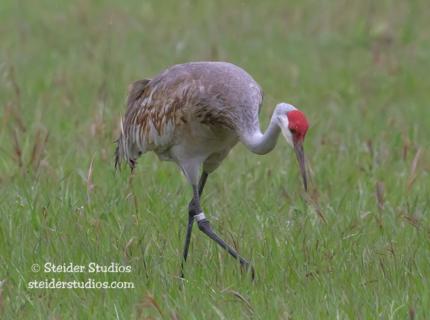
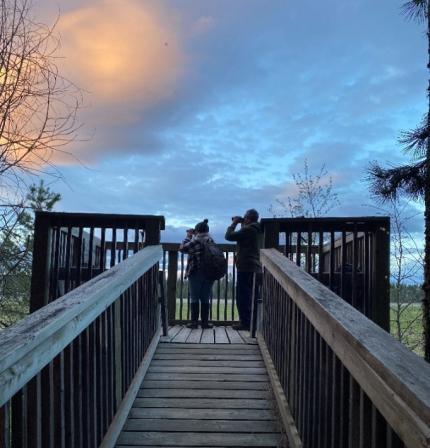
Townsend’s Ground Squirrel Surveys: In 2023, District 9 staff members visited 130 historic locations of Townsend’s ground squirrels in eastern Klickitat County to determine how many of these sites were still occupied. At a small number of those sites, occupancy was unconfirmed, meaning the surveyors found some signs of squirrels, but could not determine how fresh the signs were and did not see or hear any actual squirrels.
In April 2024, District 9 staff members revisited these sites to confirm if they were occupied or unoccupied. Unfortunately, each of these locations was determined to be unoccupied, but staff members were able to find squirrel colonies in a few new locations that had not been recorded in the past. Townsend’s ground squirrels are a Species of Greatest Conservation Need (SCGN) in Washington and are considered a candidate for state listing.
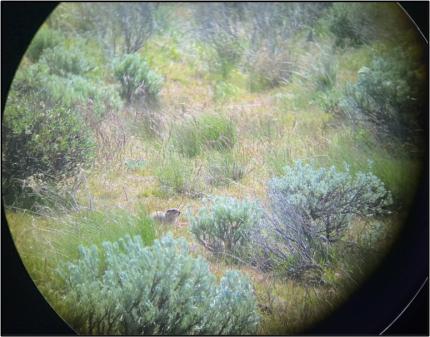
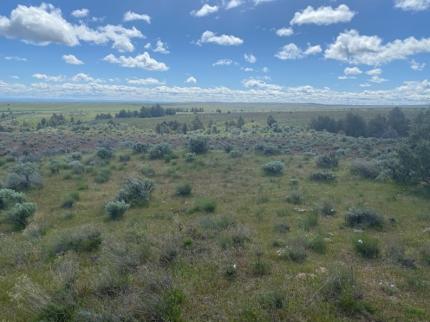
Mount St. Helens Elk Herd Population Survey: In late March, biologists from Region 5 conducted an aerial survey of the Mount St. Helens elk herd. In addition to the “core” herd area which consists of GMUs 520, 522, 524, 550, and 556 that has historically been surveyed annually or biannually, biologists also surveyed portions of the herd area to the south. The expanded survey area includes portions of GMUs 554, 560, 568, and 572. These areas are generally more difficult to survey because they have fewer clear cuts or other openings that allow observers to detect elk that are present.
Within the “core” GMUs, the same survey units are surveyed from year to year and a sight ability estimate is applied to the data collected. The estimate for the core area was 2,097 elk. This is a 38% increase from the last time this area was surveyed in March 2022 with a total of 1,522 elk. A big thanks to JL Aviation’s Pilot Pete Emmerson for his safe and skillful flying.
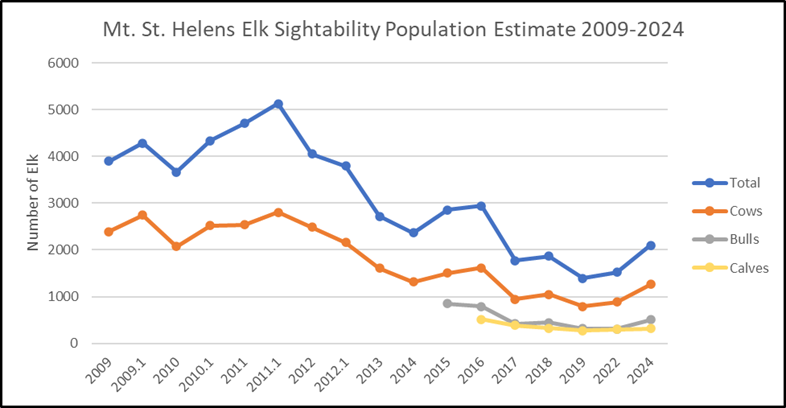
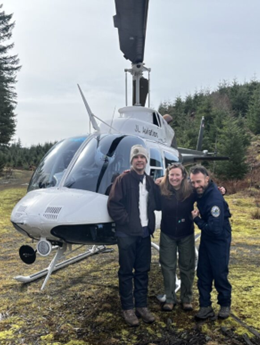
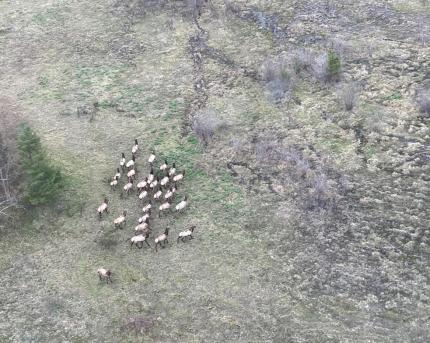
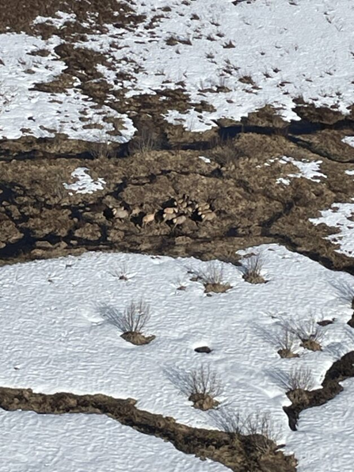
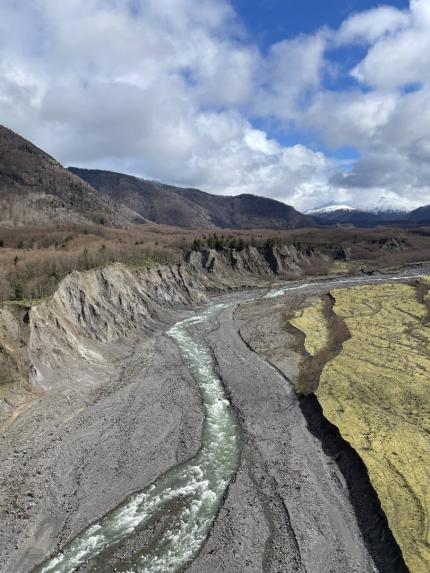
Providing Recreation Opportunities
Vandalism in Klickitat County: The restroom at the Turkey Hole Access Area was severely vandalized with graffiti in early April. Vandalism to this extent is unusual and very disappointing for Klickitat County. With two trips and multiple coats of paint, Natural Resources Specialist Celaya was able to make the restroom look respectable again.


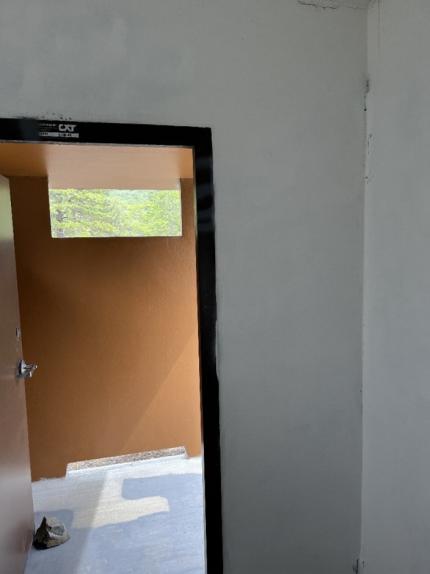
Conserving Natural Landscapes
English Ivy Removal: Cowlitz Wildlife Area staff members, with the help of master hunters and Rocky Mountain Elk Foundation volunteers who donated approximately 700 hours of their time over the four days of the project, removed over 26,000 pounds of vegetation (mostly English ivy) from the Mossyrock Unit.
The ivy is well established within the area and surgically removing the ivy without impacting the desirable vegetation is not an option. The first weekend the sun was shining, the temperature was perfect, and the crew removed 11,000 pounds of vegetation. The second week, the weather turned vengeful and kept the crew wet and cold. However, the crew rallied and removed 15,000 pounds of vegetation.
This was tough work, and the wildlife area staff members could not have done this without the volunteer help. Also essential to the success of the project were Rodger and Ramona Wallace. Rodger and Ramona not only saw the possibilities and encouraged wildlife area staff members to embrace the use of volunteers, but they also reached out to their network of volunteers and single handedly organized an army of individuals. Then, to keep morale high, they organized a potluck lunch every day of the project. With the food provided by the volunteers, you can’t beat a meal of elk burgers, German sausages, elk stew, chili, and all of the sides one could want.
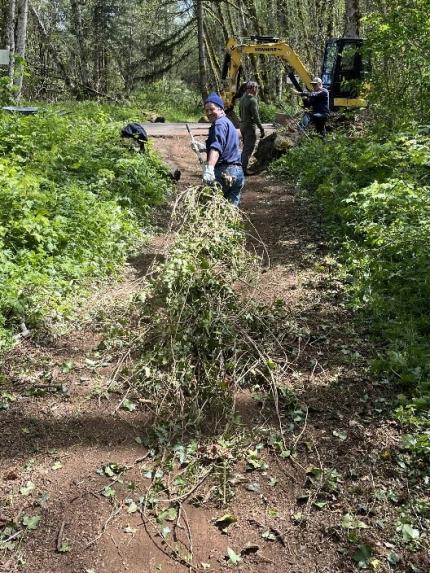
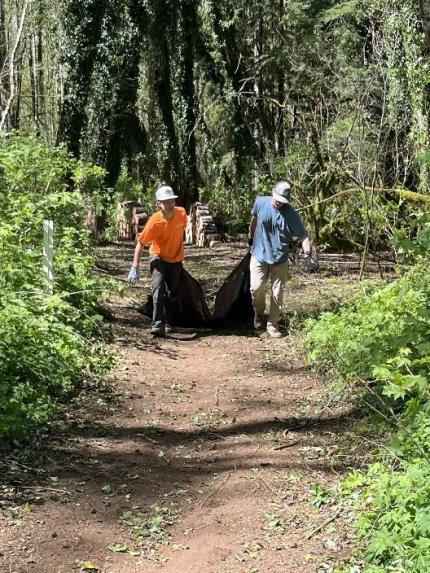
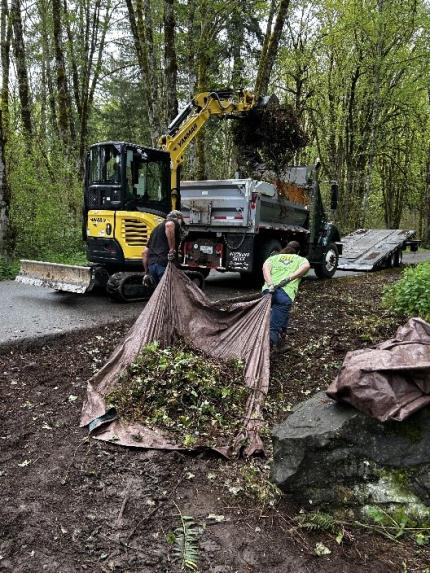
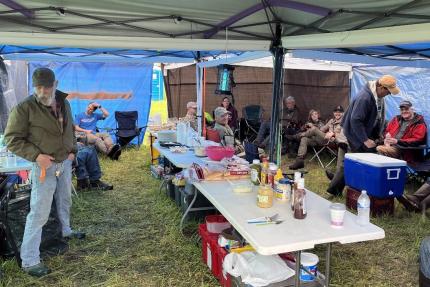
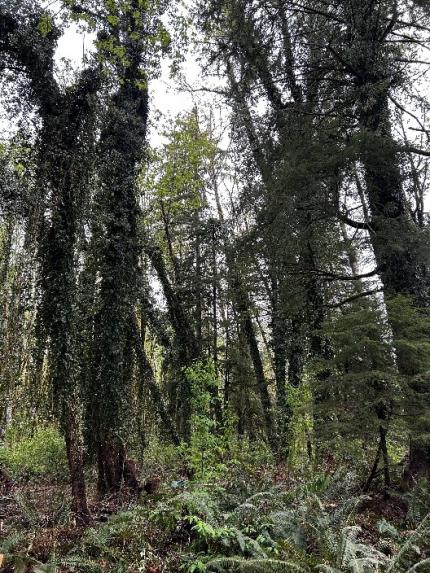
Conducting Business Operations and Policy
Chemical Immobilization Training: District biologists, conflict specialists, and enforcement staff members attended chemical immobilization training in Ridgefield. The training is required every five years for staff members who use chemical immobilization drugs.
Chemical immobilization is used when marking or collaring wildlife for research and in conflict situations when an animal may need to be removed from a dangerous situation. The training covered the types of immobilization drugs, the equipment used in immobilizations, different capture situations, and human and animal safety, among other topics. The class was capped off with dart gun practice and immobilizing domestic goats. All of the goats responded well to the drugs, maintained healthy vital signs throughout, and woke up without a problem.
